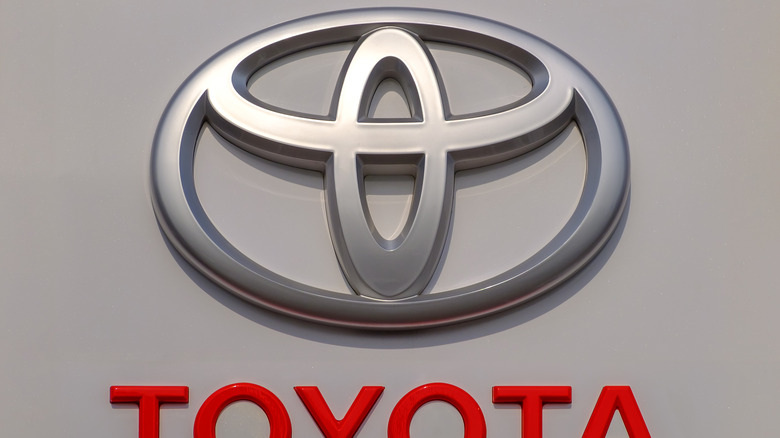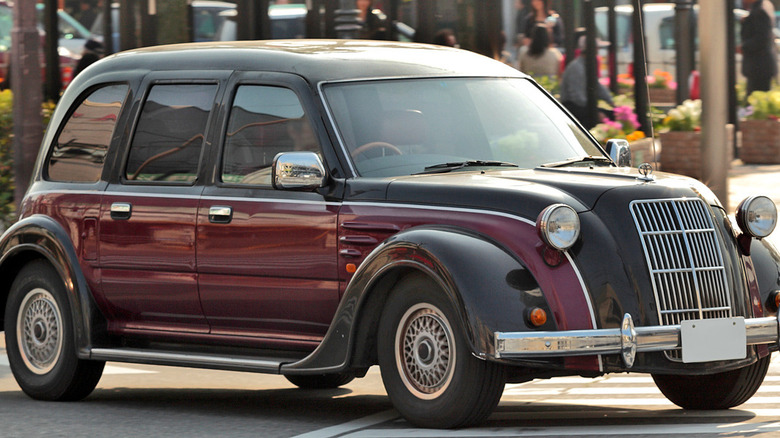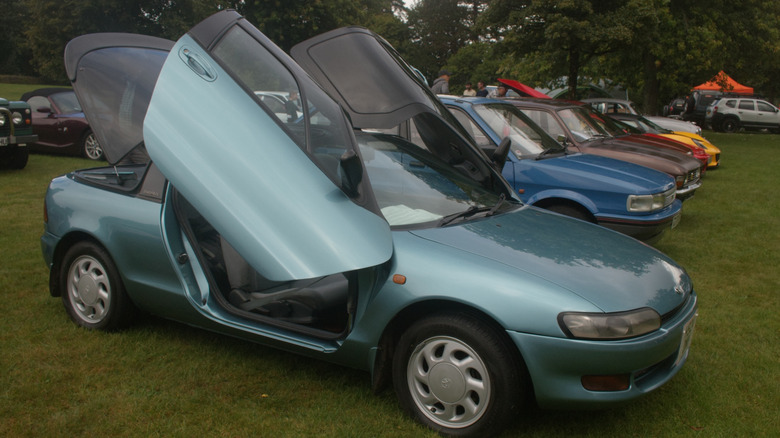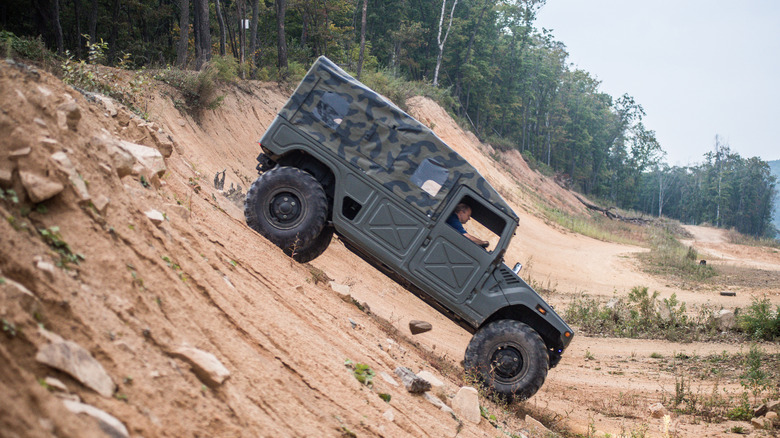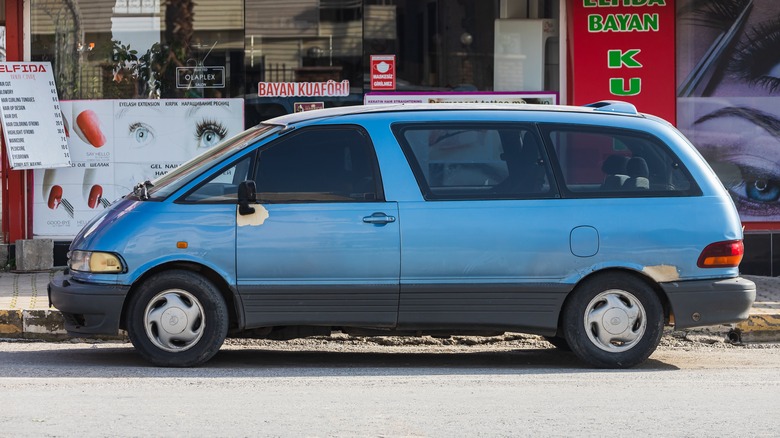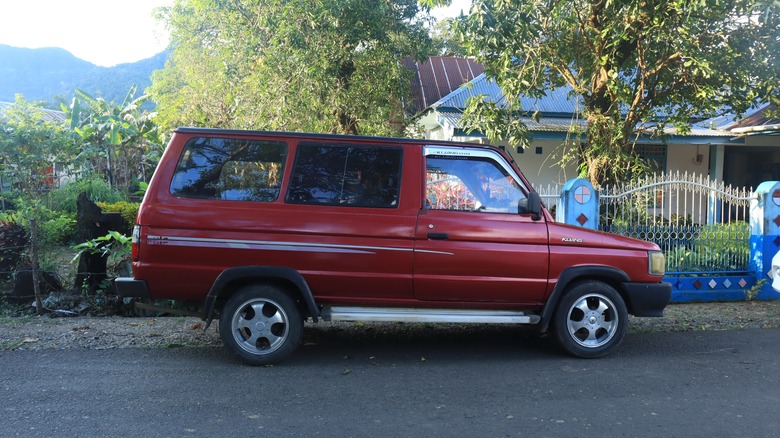The 5 Strangest Toyotas That Made It To Market
In 2022, the top-selling passenger car in the world was the Toyota Corolla, which sold over 1.1 million units. In second place, and simultaneously the best-selling SUV globally, was the RAV4 (also made by Toyota). In fact, the Japanese carmaker sold five of the world's top 10 autos in 2022, and currently ranks as the second biggest auto manufacturer in the world.
Founded in 1937, the Toyota Motor Corporation knows how to make cars that appeal to the masses. However, there's an old quote that may or may not have originated with medieval English monk and poet John Lydgate, American President Abraham Lincoln, PT Barnum, or none of the above: "You can please some of the people all of the time, you can please all of the people some of the time, but you can't please all of the people all of the time."
Whoever did say it was spot on, and it's a sentiment exquisitely showcased by some of the stranger vehicles Toyota has released over the years. Remember that most automakers purposely design different cars for different countries based on the needs, economies, and logistics of those other countries. For instance, you won't see many Hummers powering through the narrow streets of Europe unless you're watching an implausible Hollywood action blockbuster — looking at you "Fast and Furious."
Given that, it's likely that you've never heard of most — if not all — of the cars on our list.
Toyota Classic
In 1936, Toyota released the Model AA, its very first car. The American DeSoto Airflow loosely inspired it, and between 1936 and 1943, it produced only 1,404 — making them nearly impossible to find today. Toyota tried and failed to find a living example of the Model AA, but one was uncovered years later in Siberia.
Celebrate its 60th anniversary in 1996, Toyota reproduced the AA as the "Classic," an updated nod to the past. Only 100 were made and released within its primary Japanese market, making it one of the rarest Toyotas. All hundred have the same paint scheme: two-tone black and burgundy with white pinstripes. However, consumers could choose an automatic four-speed transmission, or a 5-speed manual shifter on the steering column.
The Classic sits on a Hilux rear-while drive pickup chassis, with several other parts borrowed from the truck including brakes, doors, suspension, and a 2.0-liter 96 horsepower 3Y-E inline-four cylinder engine. Additional modern amenities include current (for '97) gauges, climate control, integrated navigation system, and power windows, mirrors, and door locks.
At 16 feet, the spacious Classic had a bench-style back seat with ample leg room, a large cargo area hiding under the fake spare tire trunk lid, running boards, a wood-trimmed Nardi steering wheel, and pod-style headlights and taillights. All of which evoked cars from a bygone age, and it certainly wasn't your typical Toyota.
Upon release, the Classic sold for approximately $75,000 but can be found in various online auctions for much less.
[Image by Tennen-Gas via Wikimedia Commons | Cropped and scaled | CC BY-SA 3.0]
Toyota Sera
After getting displayed at the Tokyo Motor Show in 1987 (as the AXV-II), the Sera roared onto the streets of Japan in 1990. While it may have looked similar to other 3-door hatchback coupes of the day, the Sera (1990-1995) had a few tricks up its sleeve other cars did not.
First, the Sera looked like it could literally fly because it had gullwing passenger doors, a first for a mass-produced Japanese car. The doors arched up and became part of the roof, while the all-glass hatchback did the same, creating a full-time sunroof that mimicked a jet fighter canopy.
The downside to the glorious panoramic view? Full-time sun. Thankfully, Toyota included two large panels that could be clipped onto the doors (at the roofline) to block out the sun. Ironically, this odd Toyota inspired Gordon Murray when developing the McLaren F1 supercar.
However, unlike the powerhouse F1, the Sera has a small but efficient sixteen-valve, 1.5-liter inline-four banger (banging out 108 horsepower) under the hood. What's more impressive is what's tucked inside — a 10-speaker Super Live Sound System. With tweeters in the dash and doors, a 4-speaker sound bar mounted to the rear deck, and a massive acoustic resonance subwoofer in the trunk ... you can hear this thing coming down the road long before you see it. The speakers even had an official "Funky Mode."
Feeling funky and flying high should have been the Sera's tagline. When Toyota released the car in Japan, it had an MSRP of around $11,000. It can now be imported to the U.S., but getting a used one will likely set you back north of $17,000.
Toyota Mega Cruiser
Everyone knows the Land Cruiser, but chances are, most know little about the much bigger Cruiser that Toyota once built. Wanting to cash in on America's Humvee craze, Toyota came out with the Mega Cruiser. Much like its U.S. counterpart, the big, beefy beast was primarily used by the Japanese military, police, and other first responder units.
Only 3,000 military Mega Cruisers were built and sold between 1996 and 2002. Toyota also built a civilian model, but due to the hefty MSRP of $85,000, less than 150 rolled onto the streets — making it quite the rare find. In fact, a civvy Mega (complete with left-hand driving conversion, one of approximately a dozen) recently sold for a whopping $310,000 at the online auction site Cars and Bids.
Many consider the Mega a better version of the Humvee. First, it's bigger — 16 inches longer and almost seven inches higher (10 inches if you're sporting the "high roof" option), all while being an inch skinnier. Plus, it has four-wheel steering, giving it a turning radius of just 18.4 feet — seven feet shorter than an M1100 series Humvee (at 25 feet). Remember that a small car's average turning radius is around 31 feet, while an SUV is approximately 36 feet.
The Mega was fitted with a 4.1-liter turbodiesel inline 4-cylinder engine pushing out 155hp and 282 lb-ft of torque. It was mated to a 4-speed automatic transmission and a 2-speed transfer case.
Toyota Previa
Before the Toyota Sienna, there was the Previa, and it's the only vehicle on this list available in America. Despite being sold in the 1990s (1990-1997), it was a trendy family ride back in the day, so you may still see one of these egg-shaped minivans rolling through the streets occasionally.
Over the years, several automakers dabbled with prototypes that employed this Humpty Dumpty appearance, including Pontiac, Plymouth, and even Lamborghini. None were ever bold enough to pull the trigger on a full production run of their oblong mini-monstrosities, except Toyota.
YouTube car enthusiast Doug DeMuro called it the "weirdest minivan ever." It came in two versions: The base model had rear-wheel drive with a mid-engine design and 5-speed manual transmission. This model kicked out a relatively meager 138 horsepower. The other version however was supercharged, came with all-wheel drive, and produced 161 horsepower. Sadly, Toyota only offered this version with an automatic transmission.
That mid-engine design sounds fantastic if you're driving a sports car, but not so much in a minivan. The engine sits squarely beneath a bump in the floor between the driver and front passenger seats. To work on it, the seats had to be removed and the interior torn apart.
Even something as simple as checking the oil requires the driver's seat to be tilted back so the carpet could be moved. Underneath the carpet is what Toyota calls the "Engine Access Hole Cover," and when opened, gives you very little room to pull out the dipstick. Accessibility and convenience were obviously not a focus when Toyota designed the Previa.
Kijang
If beauty is indeed in the eye of the beholder, then behold the Kijang. Toyota has never shied away from making strange-looking cars; the Previa took the shape of an egg, and a second-generation Prius has been referred to as a pregnant roller skate. The Kijang is a line of vehicles aimed at Indonesia, Southeast Asia, Taiwan, and India markets, where roads are generally terrible and families can be considerably large.
The word Kijang means "deer" in Indonesian, which it looks nothing like. If anything, it might best be described as a wild hog with a short snout and long, husky body. Although its name is awfully close to "Kaiju," the Japanese word for giant monsters, which fits considering it's hideous.
First introduced in Indonesia in 1977, it was made available as a pickup, an extended SUV/MVP rig, and a light commercial form. Sold around the world under various badges (Revo, Qualis, Zace, Unser, Stallion, Venture, Condor, etc.), to keep things simple, Toyota refers to it in-house as "TUV," short for "Toyota Utility Vehicle."
The latest generation looks nothing like the early iterations, and is mainly considered a minivan today. It's still sold in many countries with many different options and specs. In fact, during the first quarter of 2022, the Kijang Innova was still the best-selling car in Indonesia. It has been so popular for so long that it's known as Indonesia's unofficial national car.
